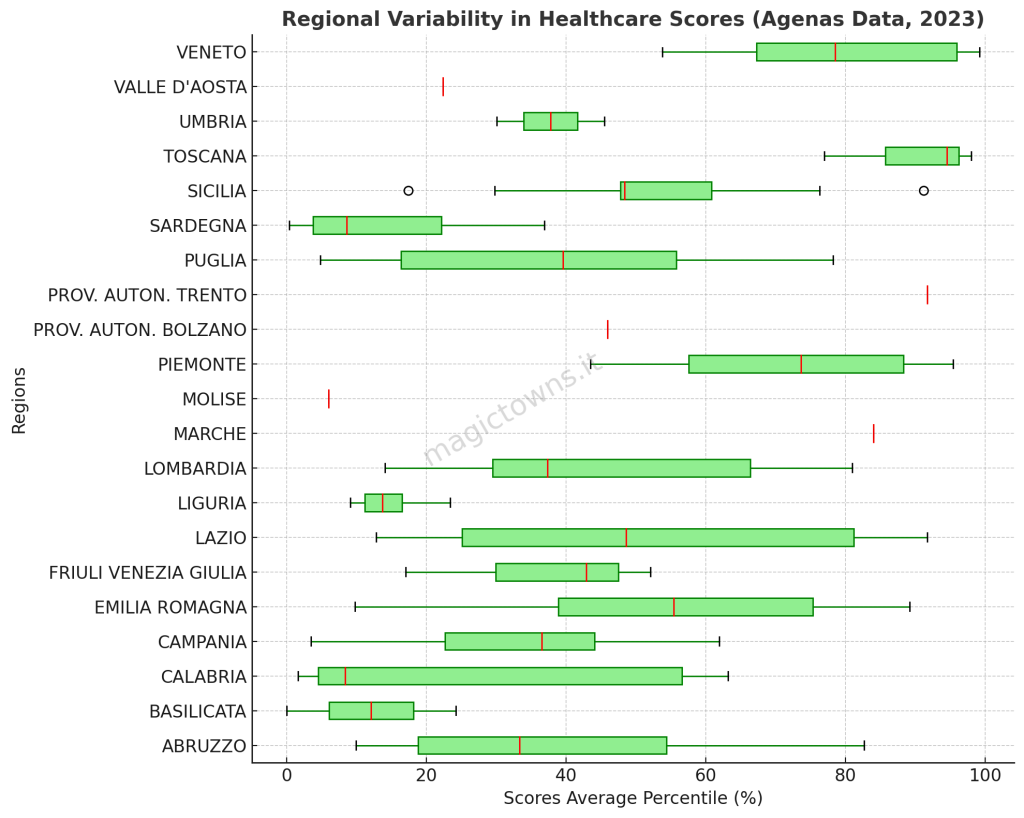Italy is widely recognised as a country with a robust universal healthcare system. In the 2023 Legatum Prosperity Index, healthcare in Italy was ranked #17 globally, nestled between Denmark and Belgium. For context, this places Italy well ahead of countries like the United States (#69) and the United Kingdom (#34). Adding to this accolade, 12 Italian hospitals were featured in Newsweek’s “Top 250 Hospitals in the World” ranking for 2024, an insight that tells a lot about the high standards of care in the country.
Universal healthcare in Italy is accessible to all legal residents, offering comprehensive coverage that includes primary care, specialist consultations, hospitalisation, and preventive services. While private healthcare options are plenty and relatively affordable, this study focuses on the public healthcare system, which remains the cornerstone of medical services for most residents.
Our analysis examines regional variations in the performance of healthcare in Italy, drawing on official data from Agenas, Italy’s national healthcare statistical agency. By simplifying and visualising this data, we have the following goals:
- Shedding light on regional disparities and highlighting areas of excellence, as well as opportunities for improvement, across the country.
- Assist prospective expats and retirees in finding areas in Italy that match their needs when it comes to healthcare.
- Simplify often difficult-to-access official data so that the general public can understand how regions of Italy perform in healthcare.
Methodology
To provide a clear and accessible analysis, we have processed and simplified the official data provided by Agenas, the provider of official healthcare statistics in Italy. The main metrics we focused on include hospital performance ratings, as well as our own summary of scores in a number of emergency and non-emergency situations, which together offer insights into hospital performance and overall healthcare delivery across regions. These metrics were selected for their ability to encapsulate both quality and efficiency in care.
Our visualisations present data in an intuitive format, such as range charts and box-and-whisker plots, highlighting both regional averages and variability within regions. These methods were chosen for their ability to visually emphasise disparities and trends, making complex data easier to interpret and accessible to a broader audience. This approach allows us to identify not only which regions excel but also where internal disparities may exist, pointing to areas in need of targeted improvements.
Healthcare in Italy: Key Findings
Our analysis revealed that healthcare in Italy displays significant regional disparities. While some regions consistently outperform others, internal variability within regions often highlights the need for targeted interventions. Key insights include:
- Top Performers: Regions like Veneto and Emilia-Romagna stood out for their high performance in both emergency care and overall hospital ratings. These regions combine efficiency with quality, making them appealing to those prioritising reliable healthcare in Italy.
- Areas for Improvement: Southern regions such as Calabria and Campania showed notable challenges, particularly in emergency response times and access to specialist care. These gaps underline the need for enhanced infrastructure and investment.
- Internal Disparities: Even within high-performing regions, variability exists. For example, while Lombardy has some of the nation’s top hospitals, discrepancies between urban centres and rural areas indicate uneven distribution of resources.
- Emerging Strengths: Regions like Sardinia, often overshadowed in national rankings, demonstrated promising improvements in preventive care metrics, suggesting effective recent initiatives.
Dreaming of your perfect place in Italy? Our Town Search lets you explore hundreds of locations across the country, tailored to what matters most to you—whether it’s climate, safety, economy, schools, or more.
Healthcare in Italy: Regional Breakdown
To provide a more digestible overview, we have grouped the country into its traditional macro-regions: North West, North East, Centre, South, and Islands. Below, we summarise how the regions within these groups performed, quoting specific ASLs/ULSSs to highlight in-region excellencies and deficits.

North West
This macro-region includes Lombardy, Piedmont, Liguria, and Valle d’Aosta. Lombardy’s urban centres, such as Milan, are home to some of the country’s top hospitals, including ASST Grande Ospedale Metropolitano Niguarda, which excelled in emergency care metrics. However, rural areas within Lombardy and Valle d’Aosta show gaps in resource distribution. Liguria’s ASL 1 Imperiese demonstrated significant delays in geriatric care, reflecting challenges tied to the region’s ageing population.
North East
Veneto, Emilia-Romagna, Trentino-Alto Adige, and Friuli Venezia Giulia form the North East. Veneto’s ULSS 6 Euganea stood out for its outstanding performance in surgical outcomes and preventive care, while Emilia-Romagna’s AUSL Romagna earned high marks for managing complex emergencies. However, Friuli Venezia Giulia revealed discrepancies between urban centres like Trieste and rural outposts, particularly in access to specialists.
Centre
Tuscany, Umbria, Lazio, Marche, and Abruzzo represent the Centre. Tuscany’s ASL Toscana Centro consistently ranked among the best in preventive healthcare initiatives. Lazio’s Policlinico Gemelli, located in Rome, is a national leader in oncology, though overcrowding in regional hospitals remains a concern. Abruzzo emerged as a relatively bright spot, with ASL 2 Lanciano-Vasto-Chieti showing significant efficiency improvements in patient outcomes.
South
The South, including Calabria, Campania, Puglia, Basilicata, and Molise, faces stark challenges. Basilicata ranked poorly overall, with ASM Matera reporting one of the lowest scores for emergency response times. Calabria’s ASP Cosenza struggled with severe underfunding, impacting access to critical services. Conversely, Puglia’s ASL Bari showed promise in maternal and paediatric care, standing out within the macro-region.
Islands
Sicily and Sardinia complete the Island’s macro-region. While hospitals in these regions generally underperform those in more developed parts of the country, Sardinia’s ATS Sardegna demonstrated marked improvements in diabetes management and preventive care, while Sicily’s ASP Palermo continues to face challenges in reaching remote populations, despite high-performing hospitals like ARNAS Civico Di Cristina Benfratelli.
Top 10 Local Areas For Healthcare in Italy
Based on our analysis, the following are the top 10 local health authorities (ASLs/ULSSs) in Italy, ranked by their performance across key healthcare metrics:
- Azienda ULSS N. 1 Dolomiti (Veneto) – This health authority is renowned for its exceptional performance in acute care, including heart attack interventions and bone fracture management. It excels in efficient hospital operations, with short recovery times and effective postoperative care.
- Azienda USL Toscana Nord-Ovest (Tuscany) – Known for its robust cardiac care and low readmission rates post-heart attack, this authority also excels in managing orthopaedic procedures. Areas for improvement include the use of less invasive techniques in breast cancer surgeries.
- Azienda ULSS N. 6 Euganea (Veneto) – With strong outcomes in surgical care and preventive health, this authority is particularly effective in timely bone fracture treatments. However, readmission rates for cardiac conditions suggest room for improvement.
- Azienda ULSS N. 8 Berica (Veneto) – This health authority is notable for its efficient handling of emergency cardiac conditions and postoperative recoveries. Breast cancer surgeries and management of heart attack scenarios present areas for development.
- ASL Città di Torino (Piedmont) – It ranks highly for minimally invasive breast cancer surgeries and heart condition management. Emergency response times and efficiency in orthopaedic care bolster its reputation.
- TO5 (Piedmont) – High scores in heart attack treatment timeliness and minimally invasive surgical techniques place this authority among the top performers, though post-heart attack readmission rates could improve.
- Azienda USL Toscana Centro (Tuscany) – A leader in preventive healthcare, this authority also performs well in managing heart attack readmissions. Orthopaedic care, however, sees slower response times compared to peers.
- Azienda ULSS N. 7 Pedemontana (Veneto) – Demonstrates strength in bone fracture management and minimally invasive breast cancer surgeries. However, challenges remain in critical cardiac treatments and hospital efficiency.
- Roma 1 (Lazio) – Excels in managing heart attack readmissions and effective bone fracture treatments. Breast cancer surgeries frequently employ minimally invasive methods, though overall hospital services could improve.
- Trento (Trentino-Alto Adige) – This health authority ranks highly for its efficiency in handling bone fractures and timely surgical interventions. While general hospital care is reliable, heart condition readmissions highlight areas for targeted improvement.
These local health authorities represent the pinnacle of Italy’s public healthcare system, offering high-quality care and innovative practices that serve as benchmarks for other regions.
Final Thoughts
While selecting a residence in the “right” catchment area is crucial for access to high-quality healthcare in Italy, it’s worth noting that the country’s system allows patients to travel to other regions for specialised treatments when necessary. However, this flexibility may be of limited use for daily and emergency care needs, where proximity to healthcare facilities plays a key role.
An important consideration for individuals and families is the distance to hospitals and clinics. Through our Quality of Life indicators, we help users assess both the quality of local healthcare and their distance to the nearest hospital. Additionally, our town search tools include filters for healthcare quality and proximity, empowering users to make informed decisions about where to live in Italy.
Sources And Further Reading
Good job! Please give your positive feedback
How could we improve this post? Please Help us.









